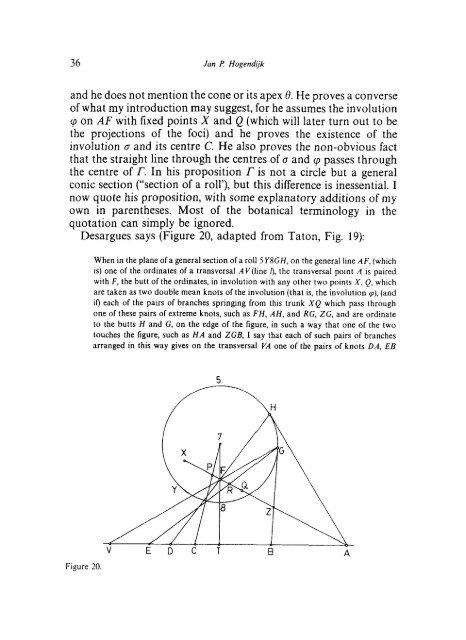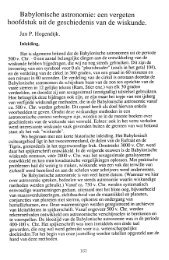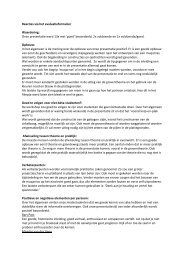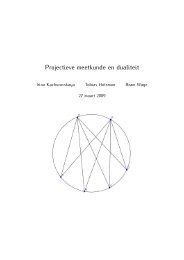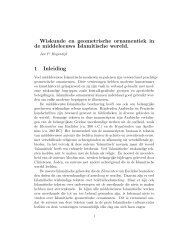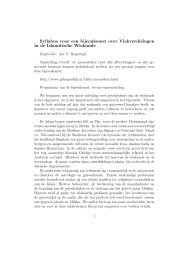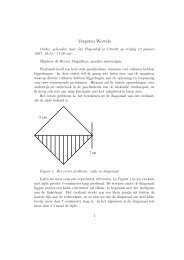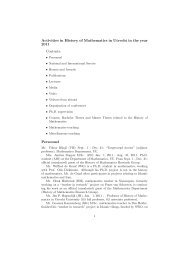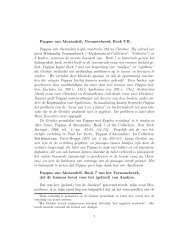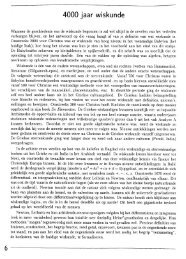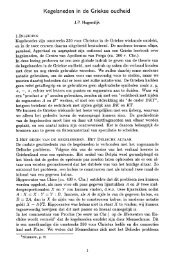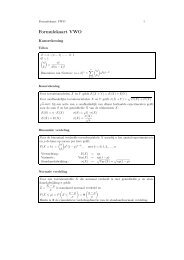Desargues' Brouillon Project and the Conics of ... - J.P. Hogendijk
Desargues' Brouillon Project and the Conics of ... - J.P. Hogendijk
Desargues' Brouillon Project and the Conics of ... - J.P. Hogendijk
You also want an ePaper? Increase the reach of your titles
YUMPU automatically turns print PDFs into web optimized ePapers that Google loves.
36 Jan l? <strong>Hogendijk</strong><br />
<strong>and</strong> he does not mention <strong>the</strong> cone or its apex 0. He proves a converse<br />
<strong>of</strong> what my introduction may suggest, for he assumes <strong>the</strong> involution<br />
cp on AF with fixed points X <strong>and</strong> Q (which will later turn out to be<br />
<strong>the</strong> projections <strong>of</strong> <strong>the</strong> foci) <strong>and</strong> he proves <strong>the</strong> existence <strong>of</strong> <strong>the</strong><br />
involution 0 <strong>and</strong> its centre C. He also proves <strong>the</strong> non-obvious fact<br />
that <strong>the</strong> straight line through <strong>the</strong> centres <strong>of</strong> CJ <strong>and</strong> cp passes through<br />
<strong>the</strong> centre <strong>of</strong> r. In his proposition r is not a circle but a general<br />
conic section (“section <strong>of</strong> a roll’), but this difference is inessential. I<br />
now quote his proposition, with some explanatory additions <strong>of</strong> my<br />
own in paren<strong>the</strong>ses. Most <strong>of</strong> <strong>the</strong> botanical terminology in <strong>the</strong><br />
quotation can simply be ignored.<br />
Desargues says (Figure 20, adapted from Taton, Fig. 19):<br />
Figure 20.<br />
When in <strong>the</strong> plane <strong>of</strong> a general section <strong>of</strong> a roll 5Y8GH. on <strong>the</strong> general line AF, (which<br />
is) one <strong>of</strong> <strong>the</strong> ordinates <strong>of</strong> a transversal AV(line f), <strong>the</strong> transversal point A is paired<br />
with F, <strong>the</strong> butt <strong>of</strong> <strong>the</strong> ordinates, in involution with any o<strong>the</strong>r two points X, Q, which<br />
are taken as two double mean knots <strong>of</strong> <strong>the</strong> involution (that is, <strong>the</strong> involution rp), (<strong>and</strong><br />
if) each <strong>of</strong> <strong>the</strong> pairs <strong>of</strong> branches springing from this trunk XQ which pass through<br />
one <strong>of</strong> <strong>the</strong>se pairs <strong>of</strong> extreme knots, such as FH, AH, <strong>and</strong> RG, ZG, <strong>and</strong> are ordinate<br />
to <strong>the</strong> butts H <strong>and</strong> G, on <strong>the</strong> edge <strong>of</strong> <strong>the</strong> figure, in such a way that one <strong>of</strong> <strong>the</strong> two<br />
touches <strong>the</strong> figure, such as HA <strong>and</strong> ZGB, I say that each <strong>of</strong> such pairs <strong>of</strong> branches<br />
arranged in this way gives on <strong>the</strong> transversal VA one <strong>of</strong> <strong>the</strong> pairs <strong>of</strong> knots DA, EB<br />
5


